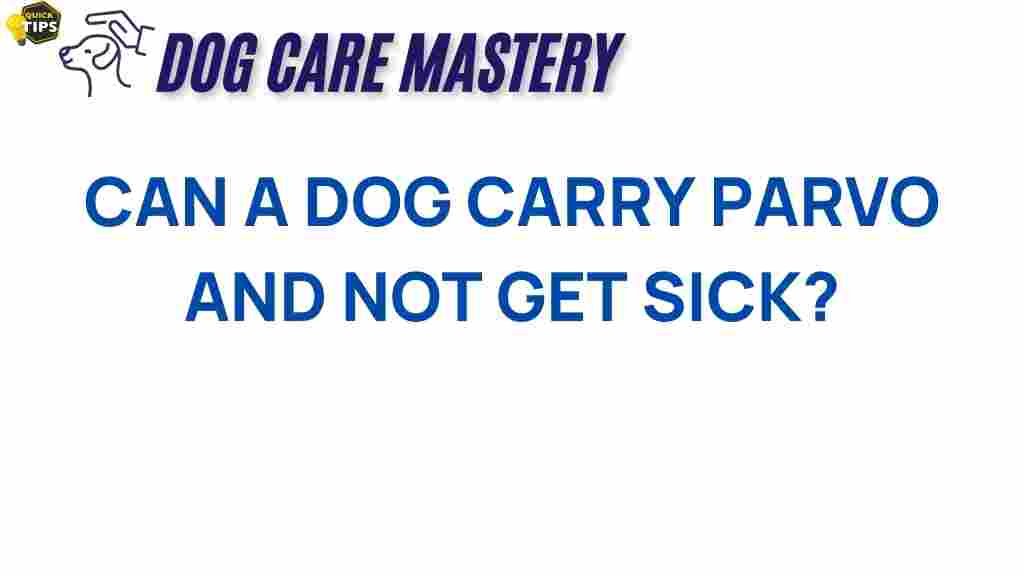The Silent Carrier: Can a Dog Have Parvo Without Symptoms?
Parvovirus, a highly contagious virus primarily affecting dogs, is a significant concern among pet owners and veterinarians alike. While many people associate parvovirus with severe symptoms like vomiting, diarrhea, and lethargy, there is a less discussed aspect of this virus: silent carriers. In this article, we will explore whether dogs can carry parvovirus without showing any symptoms and what this means for your furry friend.
Understanding Parvovirus
Parvovirus, specifically Canine Parvovirus (CPV), is a viral infection that can lead to severe gastroenteritis in dogs. This virus is particularly dangerous for puppies, unvaccinated dogs, and those with weakened immune systems. It is transmitted through direct contact with an infected dog or contaminated surfaces, feces, and objects.
Symptoms of parvovirus include:
However, the question arises: Can a dog carry parvovirus without showing these symptoms?
Can Dogs Be Silent Carriers of Parvovirus?
Yes, it is possible for dogs to carry parvovirus without displaying any symptoms. These silent carriers, also known as asymptomatic carriers, can still shed the virus in their feces, potentially infecting other dogs. This scenario is alarming, as it complicates vaccination efforts and increases the risk of outbreaks in communities.
The Mechanism Behind Asymptomatic Carriers
The ability for a dog to carry parvovirus without symptoms can be attributed to several factors:
- Immune System Response: Some dogs may possess a robust immune system that fights off the virus effectively, preventing the onset of clinical symptoms.
- Vaccination: Vaccinated dogs may carry the virus without showing symptoms, as the vaccine can provide enough immunity to prevent illness.
- Age and Health Status: Puppies and older dogs or those with health issues are at higher risk for severe symptoms, while healthy adult dogs may remain asymptomatic.
Identifying Silent Carriers
Identifying a silent carrier of parvovirus can be challenging since these dogs do not exhibit noticeable symptoms. However, there are some signs and steps you can take to assess your dog’s health:
- Regular Vet Check-Ups: Schedule consistent veterinary visits for vaccinations and health assessments.
- Monitor Behavior: Keep an eye on changes in eating habits, energy levels, and bowel movements.
- Fecal Testing: Your veterinarian can perform fecal tests to check for the presence of parvovirus, even in asymptomatic dogs.
How Parvovirus Spreads Among Dogs
Understanding how parvovirus spreads can help in preventing its transmission:
- Direct Contact: Infected dogs can spread the virus through direct interaction.
- Contaminated Surfaces: The virus can survive for months in the environment. Infected feces can contaminate yards, parks, and homes.
- Human Interaction: Humans can inadvertently carry the virus on shoes, clothing, or hands after touching an infected dog or contaminated surfaces.
Preventing Parvovirus in Your Dog
Taking preventive measures is essential to protect your dog from parvovirus, especially if you suspect the presence of silent carriers:
- Vaccination: Ensure your dog is up-to-date on vaccinations, especially puppies who should receive a series of vaccines starting at six weeks of age.
- Limit Exposure: Avoid contact with unfamiliar dogs or areas where dogs congregate until your dog is fully vaccinated.
- Cleanliness: Regularly clean your dog’s living environment and your own shoes and clothing after visiting dog parks or areas frequented by other dogs.
What To Do if You Suspect Your Dog Has Parvovirus
If you suspect that your dog has come into contact with parvovirus or is showing symptoms, follow these steps:
- Contact Your Veterinarian: If you notice any symptoms or suspect exposure, reach out to your vet immediately for guidance.
- Isolation: Keep your dog isolated from other pets to prevent potential transmission.
- Testing: Your veterinarian may recommend a parvovirus test to confirm the presence of the virus.
- Treatment: If diagnosed with parvovirus, your dog may require hospitalization for supportive care, including hydration and medications.
Troubleshooting Tips
While parvovirus is a serious concern, there are ways to troubleshoot and address potential issues:
- Stay Informed: Educate yourself about parvovirus, its symptoms, and prevention methods.
- Maintain a Healthy Diet: Feed your dog a balanced diet to strengthen their immune system.
- Regular Exercise: Ensure your dog gets regular exercise to promote overall health.
- Socialization: Properly socialize your dog in safe environments after they are fully vaccinated.
Conclusion
In conclusion, parvovirus is a serious threat to dogs, and understanding the potential for silent carriers is crucial for prevention and control. While many dogs may carry the virus without showing symptoms, responsible pet ownership, including regular vet check-ups and vaccinations, can significantly reduce the risk of infection.
If you suspect your dog may have been exposed to parvovirus or is showing any symptoms, don’t hesitate to consult your veterinarian. For further information on parvovirus, you can visit this resource on canine health.
Being aware of the silent carriers of parvovirus and taking proactive measures will help keep your dog safe and healthy.
This article is in the category Health and created by dogcaremastery Team
